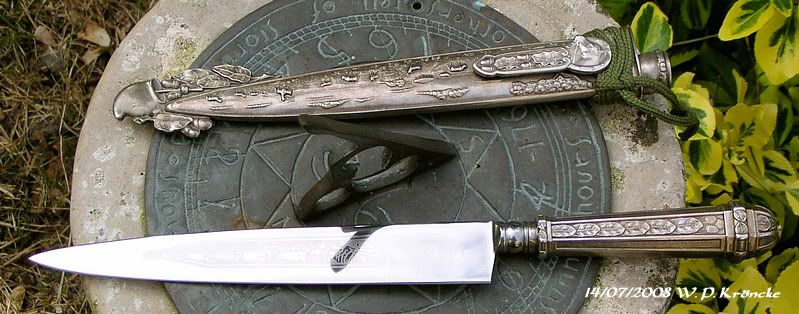
 |
|
|
|
|
#1 |
|
Member
Join Date: Jul 2006
Location: musorian territory
Posts: 448
|
it is a typical machete sword from mexico.
this style is quite common , recently ive seen quite alot of older versions being sold on ebay.. typicaly the blade has a pointed tip and is sharp for about 20cm along the back of the edge, the swords come in sheaths in the style of a machete not in a typical sword sheath. yours would have to be dated as a product of the last 70 years.. older ones are not normaly saying mad in mexico..and the etching it ushaly of a different style |
|
|

|
|
|
#2 |
|
Vikingsword Staff
Join Date: Nov 2004
Posts: 6,339
|
There is , I believe, an ersatz rendition of an Early machete with a very similar blade profile to the original subject post that has been making the rounds (unsuccessfully) on our favorite (?)
 auction site . auction site .That particular one implies a Cuban provenance . 
|
|
|

|
|
|
#3 | |
|
Member
Join Date: Apr 2007
Location: Nothern Mexico
Posts: 458
|
Quote:
Regards Gonzalo |
|
|
|

|
|
|
#4 | |
|
Member
Join Date: Sep 2008
Location: PR, USA
Posts: 679
|
Naive horses? And you can ID them by appearance?
I wonder how the racy, world-savvy type then look. Red Horse-shoes with tall heels? Just Kidding Gonzalo, couldn't help myself. Interesting the note on the reasons behind the rounded blade... Best regards & Saludos. Manolo Quote:
|
|
|
|

|
|
|
#5 |
|
Member
Join Date: Apr 2007
Location: Nothern Mexico
Posts: 458
|
Manolo, the naive or naif movement in painting (please see the Naive School in the history of art), used to represent figures in a very simple manner, almosto childish, just like on the popular art. The use of the colors was also very simple. The most known painter in this movement was el Aduanero Rousseau (Henri Rousseau). That´s what I meant with "naive horses".
Un abrazo, amigo. Gonzalo |
|
|

|
|
|
#6 | |
|
Member
Join Date: Sep 2008
Location: PR, USA
Posts: 679
|
Good answer!
To me, they just look native, but its probably because of my artistically untrained eye. Or it might be cuz' I'm tres naif myself. Tomate una cerveza fria a mi nombre! : ) Manolo Quote:
|
|
|
|

|
|
|
#7 |
|
Member
Join Date: Mar 2006
Location: Room 101, Glos. UK
Posts: 4,227
|
horsey motif's appear to fairly common decorations, as in this punal which i feel may be Brazilian.
 there are also silhouettes of 'naive' horses and cattle etched on the blade. 
|
|
|

|
|
|
#8 | |
|
Member
Join Date: Sep 2008
Location: PR, USA
Posts: 679
|
Actually, horses and their images were very common motifs in very early galician-spanish lore, weapons and shields. The old celtic religions in Galicia had a horse goddess named Epona, or something similar.
Best M Quote:
|
|
|
|

|
 |
|
|